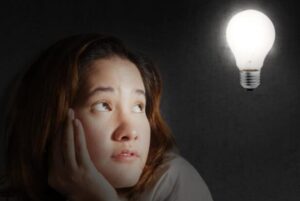It’s important to have a suitable eye protection lamp for your workplace. You want something that will protect you from stray light and keep you comfortable while doing your work.
In this article, we’ll discuss how to choose an eye protection lamp to create a better working and studying environment!
How to Choose an Eye Protection Lamp?
Light can be one of the most critical factors in a project. It is vital to have the right light for different tasks when working on projects that require precision and detail.
Eye protection lamps are used to provide safe, comfortable, high-quality illumination for any project you may be doing at home or work without any risk of eye damage.
To help make this process easier, let’s take a closer look at each factor and see which lamps will best suit your needs.
– Light Stability
The most important factor when choosing an eye protection lamp is how stable/flicker-free their light is.
For most environments, fluorescent and LED lights are the best options because they have stable light sources that don’t flicker or generate heat.
In choosing an eye protection lamp, it is essential to consider stability in color/wavelength emissions and continuous operation without flickering or excessive heat generation with no change in intensity over time.
Some types of lamps can produce a wide range of angles, while some can only produce an upward direction.
Adjustable Balanced Arm LED Desk Lamp with Dimmable Eye-Friendly Light
The shape and size will also affect the amount of light necessary – for example, if you’re looking at something intricate on a workbench that requires narrow lighting, a long and thin floor lamp may be more appropriate than one designed to illuminate large areas.
Thin Floor Lamp to Give a Lot of Light
The proper lamp height is needed to determine which eye protection lamp would be appropriate.
It is recommended that eye protection lamps be set approximately 1.5 times higher above from surface workstation to allow light to penetrate all areas.
– Color-Rendering Index (CRI)
If you are using your lamp for reading or watching movies, the CRI is a key factor. The lower the CRI, the more colors it will be hard to distinguish and see.
The higher the quality of light in your living space, the easier it will be on your eyes over time and help to reduce eye strain over time.
For example, an 80+ CRI would be preferable if you use lamps for tasks like reading or watching movies.
A 60+ CRI will suffice if all you’re doing is working with blueprints or other greyscale images.
– Brightness
When choosing a lamp for eyes, you should consider the intensity of the light created.
If you use it for extended periods, it is advisable to get a lamp with adjustable brightness.
Brightech LED Floor Lamp with Adjustable Light Intenisty
This way, as your eyes adjust to the light levels around them – in this case, they will slowly become more accustomed to a higher level of brightness – you can use less and less intense lamps.
The number of lumens you need will depend on the level of brightness required and the size of your area.
To get a rough idea, aim at 300-400 lumens for small or average-sized rooms.
– Light Color
You need to know how much light you need and what color light is easiest on the eyes.
A white light will be easier because it mimics natural sunlight.
- Cool white light is recommended in office spaces because it reduces glare and washes out colors with bluer hues;
- A warm yellow-white or cedar incandescent has advantages when relaxing or reading.
- Daylight bulbs are best for task lighting, such as while cooking or reading a map outdoors.
In addition to these qualities, the ideal eye protection lamp should also have a durable color-correct filter.
A good filter will ensure that your eyes do not feel irritated or experience fatigue after using the protective lamp. In terms of glare and shadow, you need to select a light with maximized brightness and minimal shadow.
This is because the best lamps will have an LED screen surface with uniform brightness distribution for all directions from any angle, which means it does not reflect any brighter light in certain unwanted directions.
– Light Bulb Type
The type of bulb will dictate a lot about the features and effectiveness of the lamp.
LED lamps have not been found to pose health risks like CFLs and incandescent lamps.
Modern LED bulbs produce much less heat than traditional incandescent or fluorescent bulbs.
The significant difference between the three types of lamps is that incandescent bulbs emit infrared radiation, which CFLs and LEDs do not.
The type of bulb you use depends on what you want to achieve with its light. For those looking for a softer light that won’t contribute to digital eye strain, an LED or CFL is best because it does not emit infrared radiation and will reduce glare and reflection from screens.
Light Types that Harmful to Eyes
Many types of light can be harmful to your eyes. Ultraviolet rays, blue-violet light, and high-intensity LED lights can all cause eye strain or injury.
Lighting is a crucial factor in the overall home design because it can make or break the mood and tone of any space. It’s important to know which types of light are harmful to the eyes so you can better protect your family from eye strain and potential damage.
One type of lighting that harms the eyes is fluorescent lights. Fluorescent lights produce an intense blue-violet color that may cause heada/ches, migraines, fatigue, and eyestrain when exposed for long periods.
These lights emit a high level of ultraviolet radiation, which could lead to cataracts on top of causing other eye problems like temporary blindness or blurred vision.
The next type we’ll talk about is incandescent lighting which produces harsh yellowish light. This type of light may cause eye strain, headaches, and dry eyes from exposure to the bright yellow color that can be overbearing.
LEDs are the best kind of light for your eyes because they emit a cool, blue-white light that helps to reduce eye strain.
LED lamps to have an estimated life span of about 20 years and use up to 80% less energy than incandescent bulbs while also producing much more efficient lighting in many cases.
CFLs produce yellowish-white or warm colors, which can be great if you want something softer but may not work with certain tasks such as reading on a computer screen.
FAQs
1. What is color light best for your eyes at night?
Blue light is actually better for your eyes than other colors like yellow because little blue wavelengths are what we see in bright daylight and have evolved to process the best.
LED lights can emit blue light closer to the ultraviolet range than typical incandescent bulbs, which may be less conducive to sleep patterns.
Reducing our dependence on these lights early in the day and at night could help lower or prevent eye strain.
2. Do eye protection lamps really work?
Yes, Eye protection lamps are a great choice to use over standard white lights because these lamps filter out harmful blue light, which can harm the eyes.
3. What is the best light for eye strain relief?
Natural daylight seems to be the best solution for eye strain relief. Blue LED lights might be an option if they are produced with wavelengths that are close to natural daylight.
Conclusion
Eye safety should always be your number one priority when working with any project, and eye protection lamps will give you the brightness and clarity needed without the risk of damaging your eyesight.
Additionally, they are designed specifically to help protect against glare from overhead lighting.





